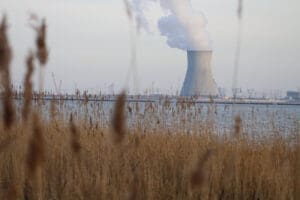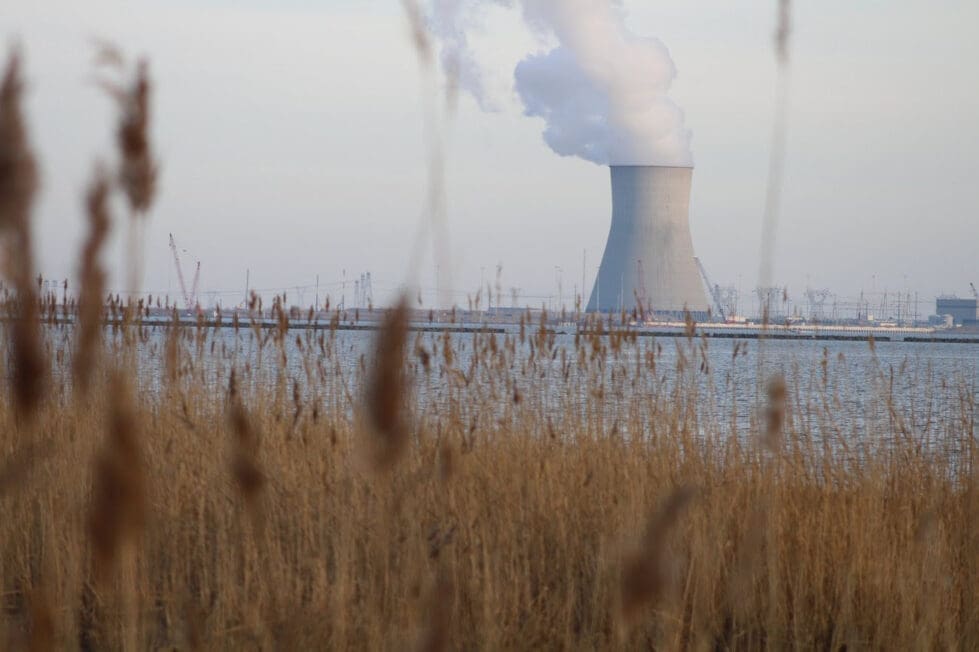

The Salem Nuclear Generating Station is at the center of a lawsuit with environmentalists that could impact fish populations and local energy costs. Photo by Jacob Owens.
A judge in an obscure administrative court in Trenton, N.J., is set to hand down a ruling that could end a challenge to the Salem nuclear plant’s ability to pump billions of gallons of water out of the Delaware River each day.
The case, which strikes at the heart of the mid-Atlantic electricity ecosystem, pits a tenacious environmental group against one of the region’s largest energy companies, and its ultimate resolution could impact electricity prices for Delawareans, the health of birds and fish in the Delaware estuary, and President Joe Biden’s most ambitious energy initiative to date.
In short, it’s the region’s biggest environmental battle that you’ve probably never heard of.
At issue is the way in which the Salem Nuclear Generating Station’s two reactors cool steam created by the heat of nuclear fission. Currently, the plant pumps cold water from the Delaware River through a system of pipes that lead it to the steam, which is then cooled back to a liquid form.
The river water then returns to the estuary, but at far higher temperatures than when it was pumped in.
In all, the process kills large numbers of fish and fish larvae, though the exact amounts are disputed.


When filed, the challenge was the latest of more than a decade of petitions, disputes and complaints brought against the Salem facility by the environmental group and its outspoken leader Maya van Rossum, who calls the power plant the largest “predator” in the Delaware estuary.
Van Rossum claims that 3 billion adult fish are killed on average each year by the plant’s cooling operations, plus billions more eggs and larvae. Those include the bay anchovy, a species that has suffered a declining local population even as larger fish, eagles, herons, and even whales rely on it for food.
“The cause of the problem for the fish is that the Salem Nuclear Generating Station is sucking them in, cooking them, ripping them apart, destroying them,” she said.
The New Jersey Department of Environmental Protection, which declined to comment for this story, suggested in their permit issued to Salem that the mortality figures cited by van Rossum and other critics are overstated.
Still, they do not appear to have presented current, counter estimates.
In the legal challenge, the Riverkeeper Network insists that the Salem plant should be retrofitted with what the industry calls closed-cycle cooling, which recirculates water used to chill the plant, consequently reducing the amount pulled from the river by upwards of 95%.
Van Rossum said an equivalent reduction in fish kills would result from such a retrofit.
“If you install the closed-cycle cooling, you’re reducing the cold water intake,” she said “And there’s a direct relationship – you’re reducing the fish kills.”
The Hope Creek Generating Station, a sister nuclear power plant that sits beside the Salem facility, uses closed-cycle cooling.
During the early 2000s, the U.S. Environmental Protection Agency issued new rules mandating that new large power plants use closed-cycle cooling.
For existing plants, such as the Salem facility, the agency ruled that the “best technology available” be utilized.
Could Salem shut down?
What constitutes the best technology is not a simple determination.
In the permit issued to the Salem plant, New Jersey regulators stressed that “mortality statistics alone” should not be the only factor in determining the best way to cool a power plant.
The costs of a retrofit should also be considered, they said.
Attorneys for the majority owner of the Salem plant – Public Service Enterprise Group, or PSEG – similarly argue that economic considerations be taken into account.
And, they said, retrofitting the facility with closed-cycle cooling is too costly to justify any environmental benefits achieved.
In their case against the Riverkeeper Network, PSEG attorneys last year filed a motion for summary judgment, which remains pending to this day before a judge in the New Jersey Office of Administrative Law.
If the motion is granted, the case will end in favor of PSEG. If not, it will progress to an official administrative hearing.
While PSEG officials did not reply to requests to comment for this story, the company has warned shareholders in recent years that the Riverkeeper’s legal challenge could “adversely impact the economic competitiveness” of the nuclear facility.
Though jargony, PSEG’s statement implies that it could potentially shutter the Salem facility if it loses the case against the Riverkeeper Network.
Such a scenario could jolt the regional market for electricity and potentially lead to spikes in the cost of power. The Salem plant is the third largest nuclear power plant by generating capacity in the PJM network that serves the tri-state area.
But van Rossum sees it as an empty threat.
“They’re not shutting down. They keep getting life extensions and we can see the next life extension coming with the hydrogen hub,” she said, referencing a recently announced initiative to build a hydrogen fuel production hub in the mid-Atlantic.
In its reports to shareholders, PSEG did not reveal a cost estimate for retrofitting its Salem plant with a new cooling system.
But, a consultant’s report examining the economic implications of installing a closed-cycle cooling system at Salem cited a PSEG filing from 2006 that had put the cost at $852 million.
In today’s dollars, the cost is likely double that sum as the construction industry has been hit particularly hard by recent inflation.
Last year, PSEG reported its profit at just over a billion dollars for 2022. The company will report its 2023 earnings later this month.
Despite strong earnings, PSEG officials have threatened to close their nuclear plants on the Delaware River.
In 2019, they said in regulatory documents filed with New Jersey that the Salem and Hope Creek nuclear facilities would cease operations unless state officials came to the rescue with new subsidies.
Months later, the state’s public utilities board responded with a $300 million award to the company.
Is hydrogen Salem’s future?
The Salem nuclear facility consists of two units that collectively produce nearly 2,300 megawatts of electricity annually – enough to supply the electricity needs of about 2 million homes.
In the future, the power is expected to play a key role in President Biden’s plans to remake the mid-Atlantic into a hydrogen production and distribution hub.
In October at the Port of Philadelphia, Biden announced that a consortium of politically powerful companies in Delaware, South Jersey and southeast Pennsylvania would receive $750 million from the U.S. Department of Energy to build a cluster of hydrogen fuel facilities across the mid-Atlantic region.
The consortium, which calls itself the Mid-Atlantic Clean Hydrogen Hub, or MACH2, includes DuPont, Chemours, W.L. Gore & Associates, Air Liquide, Bloom Energy, Delaware City refinery owner PBF Energy, Croda and PSEG, and others.
The Department of Energy also gave seven other regional hydrogen consortiums similar awards.
MACH2’s exact plans have not been publicly released, but consortium members have touted that their plan was the only truly carbon-free plan that would produce hydrogen using a mixture of offshore wind power, solar farms from around the region, and nuclear power from the Salem and Hope Creek plants.
More recently, that planned mix of energy has likely been disturbed after Danish wind farm giant Ørsted abandoned its plans to build offshore wind farms in New Jersey.
IN THE NEWS: School board vets say new members can have an almost immediate impact
As a result, PSEG’s nuclear plants will likely become more critical to MACH2’s overall success.
Nevertheless, key details of the MACH2 plan — including a list of projects to be funded with the $750 million — are not publicly known.
An open records request for the bid is pending with the U.S. Department of Energy.
Coincidentally, the loudest environmental critic of Biden’s hydrogen plan has been van Rossum and the Riverkeeper Network.
Following Biden’s announcement last year, Delaware Public Media quoted Rossum as among a small contingent of environmentalists criticizing MACH2’s reliance on the Salem reactors because of their heavy impact on the surrounding estuary.
Van Rossum also questioned the efficiency of utilizing wind or solar power to produce hydrogen, instead of directly using it to power homes and cars.
MACH2’s chairman Collin O’Mara, who may run to be Delaware’s next governor, did not immediately respond to requests to comment on van Rossum’s critiques.
This story was produced by Spotlight Delaware, a community-powered, collaborative, nonprofit newsroom covering the First State. Learn more at spotlightdelaware.org
Share this Post








